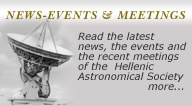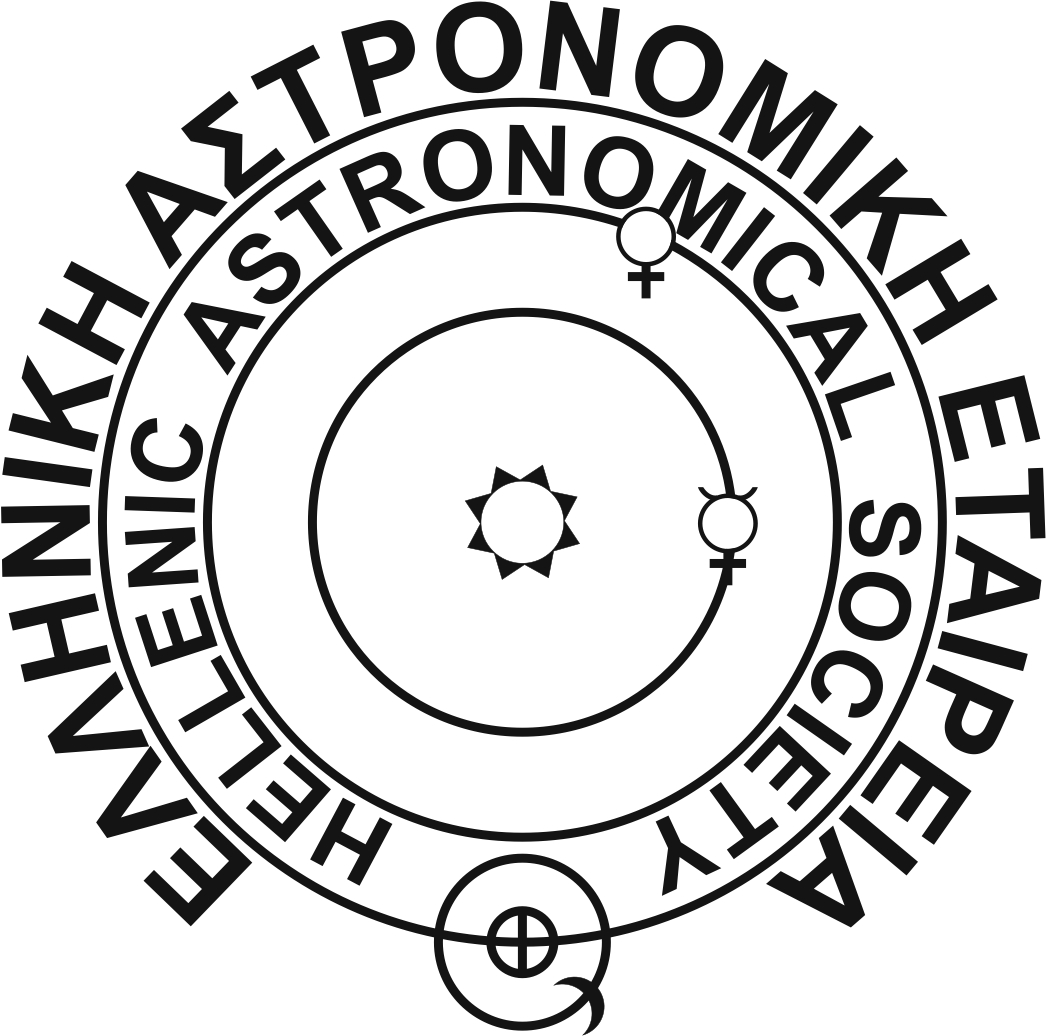%%%%%%%%%%%%%%%%%%%%%%%%%%%%%%%%%%%%%%%%%%%%%%%%%%%%%%%%%%%%%%%%%%%%%%%%
HELLENIC ASTRONOMICAL SOCIETY
ELECTRONIC NEWSLETTER
NUMBER 73 March 2004
------------------------------------------------------------------------
E-mail: elaset@astro.auth.gr WWW: http://www.astro.auth.gr/elaset
------------------------------------------------------------------------
TOPICS:
1. Short News
2. Candidates for the GC of HelAS
3. Finland Joins ESO
4. The NEON Archive Observing School
5. Educational Video on Nucleosynthesis Available for FREE
6. Launching of Rosetta Spececraft
7. Upcoming Astronomy meetings in Greece
8. About this newsletter.
1. SHORT NEWS
-------------
A new scientific association was formed by the previous/current
holders of the EC Marie Curie fellowships. The website of the Greek
section of this Marie Curie Fellowships Association is :
http://www.mariecurie.org/el/. We congradulate our member Dr. Emilios
Harlaftis (NOA) who was recently elected as its president.
An academic ranking of world's Universities for 2003 appeared in
CORDIS FOCUS http://www.cordis.lu/focus/en/ (Issue of 26-1-2004) and
can be found in : http://ed.sjtu.edu.cn/ranking.htm
2. CANDIDATES FOR THE GC of HELAS
---------------------------------
As announced in the previous newsletter the deadline for nominations
of candidates for the Governing Council of HelAS, was February 29th.
The nominations received from many members of HelAS by the Secretary are:
- Candidate for President:
o Laskarides Pavlos
Position: Professor, Dept. of Physics, Univ. of Athens
- Candidates for the Governing Council:
o Tsinganos Kanaris
Position: Professor, Dept. of Physics, Univ. of Athens
o Geroyannis, Vassilis
Position: Professor, Dept. of Physics, Univ. of Patras
o Daglis Ioannis
Position: Research Director, National Observatory of Athens
o Dara, Eleni
Position: Research Director, Research Center for Astronomy and Applied
Mathematics, Academy of Athens
o Kokkotas Konstantinos
Position: Associate Professor, Dept. of Physics, Univ. of Thessaloniki
o Moussas Xenophon
Position: Associate Professor, Dept. of Physics, Univ. of Athens
o Vlahos Loukas
Position: Associate Professor, Dept. of Physics, Univ. of Thessaloniki
o Hatzidimitriou Despoina
Position: Assistant Professor, Dept. of Physics, Univ. of Crete
o Kontiza Maria
Position: Assistant Professor, Dept. of Physics, Univ. of Athens
o Theodossiou Efstratios
Position: Assistant Professor, Dept. of Physics, Univ. of Athens
o Georgantopoulos Ioannis
Position: Senior Researcher, National Observatory of Athens
- Candidates for Auditors:
o Mavromichalaki, Eleni
Position: Associate Professor, Dept. of Physics, Univ. of Athens
o Danezis Manos
Position: Assistant Professor, Dept. of Physics, Univ. of Athens
o Stergioulas Nikolaos
Position: Assistant Professor, Dept. of Physics, Univ. of Thessaloniki
o Grammenos Theofanis
Position: P.D. 407 Professor, University of Thessaly
o Manimanis Vassilios
Position: Researcher, Dept. of Physics, Univ. of Athens
o Xilouris Manolis
Position: Assistant Researcher, National Observatory of Athens
The information the candidates may provide on their profile will
be given in a future electronic newsletter.
3. FINLAND JOINS ESO
--------------------
On the 9th of February 2004, during a ceremony at the European
Southern Observatory (ESO) Headquarters in Garching (Germany), an
Agreement was signed by the Finnish Minister of Education and
Science, Ms. Tuula Haatainen and the ESO Director General,
Dr. Catherine Cesarsky. Following subsequent ratification by the
Finnish Parliament of the ESO Convention and the associated
protocols, it is foreseen that Finland will formally join ESO on July
1, 2004, becoming its eleventh member state.
More information on this event can be found at:
http://www.eso.org/outreach/press-rel/pr-2004/pr-02-04.html
Hopefully the conditions will be such that Greece will also be able
to join ESO in the future. As a reminder to our members this was
considered the top priority for Greek astronomy in the report to the
Greek National Committee for Astronomy by an external committee
chaired by Prof. Yervant in 1998. This report was made public during
the meeting "Astronomy in Greece at the Gates of the 21st Century",
which was organized at the National Observatory of Athens on the 12th
of November 1998, and it is available at:
http://www.astro.noa.gr/gnca/NEWS/ca-report2000.htm
4. THE NEON ARCHIVE OBSERVING SCHOOL
------------------------------------
The fourth Neon school (or first one in the new series) will take
place at ESO-Garching (Germany) from July 14 to 24, 2004. The
registration deadline is April 30th, 2004. For more information
visit:
http://www2.iap.fr/eas/neon4.html
The principles are the same as in previous schools: introductory
lectures on topics of general interest, work in small groups,
execution of a real research project, presentation of the results at
the end of the school. However, instead of using new data obtained at
the telescope, the scientific programs will be conceived around the
use of archival data, from ground telescopes or from space
observatories. Emphasis will therefore be put specifically on the
analysis of data quality and on multi-wavelength research.
Financial conditions: due to the lack of EU funding, participating
students are expected to pay their travel expenses, and board and
lodging expenses themselves (from their home institution money). The
school will however be free of charges.
The school is open to PhD students or post-docs with limited
observing experience from all over Europe (including the far east).
A limited amount of financial support is available for students
coming from countries/institutes with small resources.
5. EDUCATIONAL VIDEO ON NUCLEOSYNTHESIS AVAILABLE FOR FREE
----------------------------------------------------------
The educational video on nucleosynthesis "Element Genesis - Solving the
Mystery ", by RIKEN (The Institute of Physical and Chemical Research)
of Japan is available for distribution. Produced by RIKEN two years ago,
this 34-minute educational science video discusses nuclear astrophysics
focusing on the birth of the elements. Distribution of the English edition
for use in educational institutions is now available free of charge from
RIKEN to colleges and other academic institutions. This release is for a
limited number of VHS videotapes for France, Russia, Greece, and any other
countries where are suitable for SECAM format. If you would be interesting
in using this video, information on the video and application for academic
distribution is provided at: http://www.rarf.riken.go.jp/video/
6. LAUNCHING OF ROSETTA SPACECRAFT
----------------------------------
The one billion Euros European Space Agency's (ESA) Rosetta spacecraft
was successfully launched from Kourou, French Guiana on the 2nd of March.
Rosetta will be the first craft to both chase and land on a comet.
Rosetta comprises a large orbiter and a small lander. Between them, the
two components are carrying 20 scientific instruments designed to complete
the most detailed study of a comet ever attempted. The instruments include:
an ultraviolet imaging spectrometer; a grain impact analyser and dust
accumulator; a micro-imaging analysis system; an alpha proton x-ray spectrometer;
an evolved gas analyser and a RoLand magnetometer and plasma monitor. The
spacecraft and upper stage remained in the Earth's orbit for around two hours
after lift-off. The upper stage then ignited to boost Rosetta into its
interplanetary trajectory and separated from the spacecraft. The spacecraft
will now set off on its long Solar System journey that will take it around
the Sun four times, around Mars once (2007), the Earth three times (2005,
2007, 2009), and into the asteroid belt twice. The target of the mission,
Comet 67P/Churyumov-Gersimenko, has a nucleus about four kilometres wide
and orbits around the Sun every 6.6 years. Rosetta will orbit the Comet,
observing what happens as the icy nucleus approaches the Sun and then moves
away from it. Rosetta's industrial team involves more than 50 contractors
from 14 European countries and the US. For further information, you may consult
the following web address: http://www.esa.int/export/SPECIALS/Rosetta/index.html
7. UPCOMING ASTRONOMY MEETINGS IN GREECE
----------------------------------------
The following meetings will take place in Greece in the coming
months. Please check the corresponding web pages or contact the
organizers by e-mail for more information.
*************************
''The Environments of Galaxies:from Kiloparsecs to Megaparsecs"
Chania, Crete 9-13 August 2004
More information at:
http://astronomy.swin.edu.au/conferences/crete2004/
*************************
8. ABOUT THIS NEWSLETTER
-------------------------
This Newsletter was edited by Vassilis Charmandaris and Kanaris
Tsinganos. It was forwarded to the 228, out of the 253, members of
Hel.A.S. who have e-mail access.
The next edition of the Newsletter will be mailed around April 1st
2004. Please send your announcements (e.g. appointments/departures,
job openings, research opportunities, awards, conferences in Greece)
or comments before March 25, 2004. All correspondence concerning
the Newsletter should be addressed to:
elaset@astro.auth.gr and tsingan@phys.uoa.gr
If you do not wish to receive future issues of this Newsletter or the
e-mail address to which it was sent is not your preferred one, please
let us know.
------------------------------------------------------------------------
END-------HELLENIC ASTRONOMICAL SOCIETY ELECTRONIC NEWSLETTER--------END
------------------------------------------------------------------------







